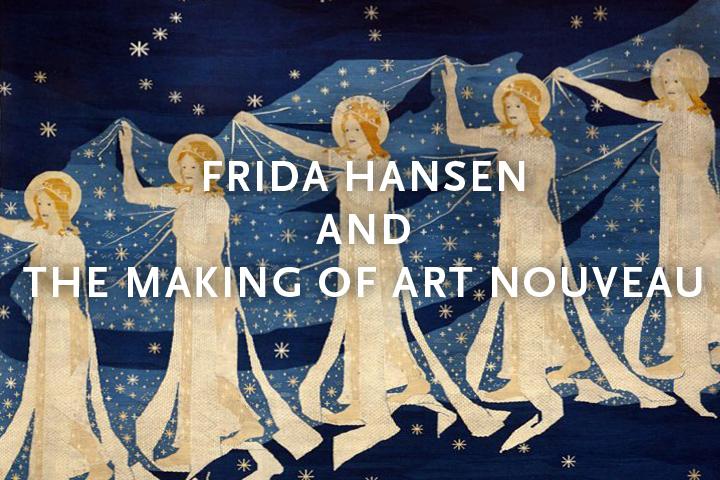January 19, 2018

(Above: an image of Frida Hansen's "Melkeveien" or "Milky Way" tapestry, one of her famous and most notable pieces.)
(Above: this piece, part of Frida Hansen "Door Curtain" series, was most recently on display from January to April 2017 at the Statens Museum for Kunst, Copenhagen.)
Internationally-acclaimed Norwegian tapestry artist Frida Hansen left an indelible mark in the world of interior design. She stood as one of the forebearers that bridged the gap between Norwegian and European tapestry art.
Hansen was the face of the Art Nouveau and Symbolism movements during the turn of the century, having gone against the artistic tides of the time.
(Above: Hansen's "I Rosenhaven" tapestry. Norwegians today have a renewed interest in Norwegian textiles and hail Frida as a pioneer due to her works incorporating an international appeal.)
Much of the art from this period consisted of natural affinities to art. In contrast, Hansen stuck to a more illogical and sensual vision, much like her Art Nouveau compatriots.
Alongside other Nordic artists like Gerhard Munthe, she participated in the fervent Nordic spirit of the time Japanomania, suffusing art pieces with Japanese references, artistic methods, and themes. Truthfully, the usage of Japanese art technique and culture had influenced both her Norwegian tapestries as well as her very own personal ethos.
(Above: tapestry by Gerhard Munthe, a fellow artist who helped shape the Art Nouveau Movement and utilizes his independent designs inspired by Norwegian folk art and Oriental influence in his works as well. His exhibit “Enchanted Design” will be on display at The National Gallery in Oslo, Norway from June 8th-Sept. 2018.)
The Orient has always been an incredible source of inspiration for tapestries. Hansen worked with Japanese references not only as a personal homage to Japanese culture, but also as a signal to the public that she, and anyone participating in the Japanomania culture for that matter, was now part of something broader, something better and less conformist.
Frida’s unique color palette and dying methods were developed during her formative years in Stavanger and influenced at least in part by local weavers in Jæren and Ryfylke.
Her line of textile weavings consisted of tapestries that were large and suffused with floral designs and themes.
(Above: "Summer Nights Dream" is handwoven and made from a unique combination of wool in the warp with wool and wire in the weft.)
Hansen not only excelled as an artist, but also combined her ingenuity and craftsmanship with entrepreneurship.
In her floral productions, she created a partition technique that allowed her to navigate between woven and nonwoven “transparent openings.” For her dyeing techniques, Hansen fostered methods in a natural dye laboratory that she had made herself.
Truthfully, Hansen was her very own one-stop-shop in a textile world that she had already begun shaping herself.
(Above: Paris Exhibition Universelle, 1900 where Frida earned critical acclaim for her award winning tapestry, "Milky Way".)
Frida earned critical acclaim as a textile artist at the World’s Fair in Paris with her release of the tapestry “Milky Way” (1898), for which she won a gold medal.
To note, during Hansen’s time, Olympic athletes were awarded paintings rather than medals. The fact that art had made its way into sports illustrates the level of influence that art and painting had the time; that Hansen had actually won a gold medal for her Milky Way tapestry reveals Hansen’s impact during this time.
Even though Hansen’s line of work earned her praise in the early 1900s, she quickly became a thing of the past, and it wasn’t until 1973 when she was officially recognized at the Museum of Decorative Arts and Design in Oslo as the leading pioneer in the world of textile art.
Norwegians have renewed their interest in textile art, and Hansen’s floral themes along with her plant-dyeing methods are once again beginning to shape the ecological purview at large.
(Above: Before and after 1900, Norwegian institutions focused heavily on tradition and Norwegian identity. Because her works gained a more international appeal, Hansen primarily sold her pieces to international museums.)
Since the public unveiling of her tapestries in 1973 at the Museum of Decorative Arts and Design in Oslo, Frida Hansen tapestries have appeared in various museums. Her tapestry recently appeared at the Ateneum Art Museum in the Finnish National Gallery, which hosted the exhibit Japanomania in the Nordic Countries.
Currently, she holds public sway as being one of the greatest contributing textile designers to influence recent textile art in Europe.
